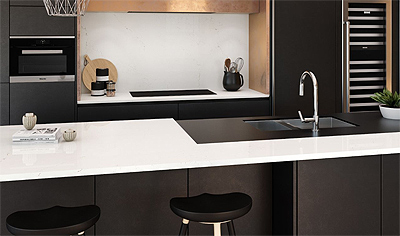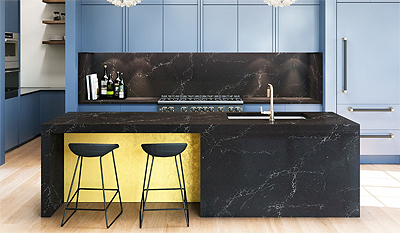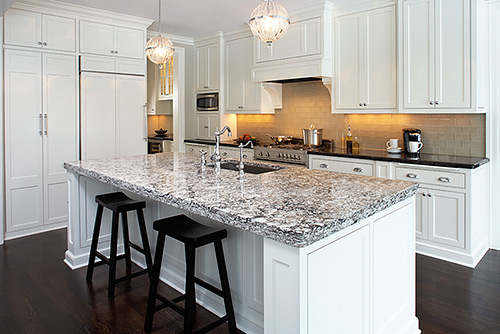
.png)
Search By Square Foot
• Up to 1000 Sq Ft
• 1001 - 1500 Sq Ft
• 1501 - 2000 Sq Ft
• 2001 - 2500 Sq Ft
• 2501 - 3000 Sq Ft
• 3001 - 3500 Sq Ft
• 3501 - 4000 Sq Ft
• 4001 - 4500 Sq Ft
• 4501 - 5000 Sq Ft
• 5001 Sq Ft And Up
Search By Square Foot
• Up to 1000 Sq Ft
• 1001 - 1500 Sq Ft
• 1501 - 2000 Sq Ft
• 2001 - 2500 Sq Ft
• 2501 - 3000 Sq Ft
• 3001 - 3500 Sq Ft
• 3501 - 4000 Sq Ft
• 4001 - 4500 Sq Ft
• 4501 - 5000 Sq Ft
• 5001 Sq Ft And Up
by Rachel Lyon, Editorial Director for The House Designers®
Choosing the right countertop material can seem as difficult as deciding on a color and pattern. Price, performance, and upkeep needs all must be considered to ensure you select a countertop that stands up to the challenges of your household. Many people are drawn to the beauty of natural stone slabs like marble and granite, but they come with a hefty price tag up front and throughout the lifetime of the countertop. If you want a better investment that delivers natural stone looks and the appeal of a natural material, consider quartz instead—here’s why it comes out on top across the board!

Sustainability
Whether natural stone or quartz slabs, sourcing materials begins in a quarry. Natural stone is extracted from the earth in large blocks, a process that requires a lot of heavy machinery and that leaves the surrounding environment scarred. Quartz, on the other hand, is extracted as crushed stone, which is a lot easier on the landscape. Loss is also minimized—since quartz crystals will be ground down and reformed into slabs, every piece can be used. The same can’t be said for natural stone, because it can break awkwardly during mining, will be trimmed to shape through processing, and needs to emerge as solid, contiguous slabs in the end.
When you take a step back to look at the entire process, quartz remains the clear winner in terms of environmental friendliness. A wide variety of marble and granite deposits exist around the world; every type is inevitably shipped across continents to cater to demands. Given the weight and likelihood of more loss through breakage in transit, natural stone comes with a hefty carbon footprint. Quartz keeps it relatively local; all sorts of slabs can come from a single quarry because manufacturers add pigments and veining details in the factory to create different designs. That means more options are available in one place, and you don’t have to look too far for something you like. It also takes a lot less fuel to get the perfect countertop delivered!

Durability
Breakage is a major concern for natural stone, so you’re probably wondering why quartz—which is largely made of the same stuff, elementally—can be so much more robust. It comes down to consistency! Natural stone is not uniform—it is peppered and streaked with impurities that are often beautiful to behold, but also prone to cracking. A quartz slab is homogeneous throughout, composed of quartz crystals, some pigments, and binders to hold it all together—it does not have the same kind of weakness. Just as quartz is less likely to be damaged when shipping, it gives you a hardier surface to work on.
The density of the slab also matters, and quartz is exceptionally dense. It is harder than marble and granite, so it’s less likely to chip and scratch. The surface is also nonporous, so it won’t absorb water, be damaged by acidic spills, or take on stains. Quartz definitely earns top marks when it comes to handling everyday challenges, and that’s exactly what we all need from countertops.

Maintenance
As you could imagine, the more durable the material, the less care it needs. This is where quartz countertops set themselves apart most of all! To keep a quartz surface clean and looking great, just wipe it down with some mild soap or an all-purpose household cleaner. Natural stone, as porous as it is, needs to be sealed every one or two years, and you have to be careful about the cleaners you use. If you don’t reseal often enough, or you use cleaners that break down the sealant, the surface will absorb moisture, discolor, and even harbor germs. You should only purchase natural stone if you can commit to its ongoing care; otherwise, you won’t be happy with how it ages. If you don’t want to sign up for that continual expense, invest in a marble- or granite-look quartz countertop instead.

Availability
As mentioned before, quartz is a manufactured product. That means the manufacturer controls what the slab looks like, and you’re not at the mercy of millions of years of geological processes. If you have a particular aesthetic in mind, you will have an easier time finding it in quartz than natural stone, where the look can vary drastically across slabs. It can also cost a fortune to import stone depending on where the quarry is located. Whatever look you’re going for, the availability and accessibility of quartz will make it much easier to find what you want.
If you’re in the market for some new countertops, check out what Cambria® has to offer! This family-owned American business takes a sustainable approach to quartz—they backfill and restore their mining sites, rely on a domestic supply chain and rail transportation to reduce carbon emissions, and recycle water and scrap materials to slash waste—and offer a large catalog of designs, many of which are inspired by naturally occurring marble and granite from around the world. Of course, you’ll also find plenty of unique designs across a range of neutral and colorful hues. Find a local dealer who can help you find the perfect countertops for your whole home!